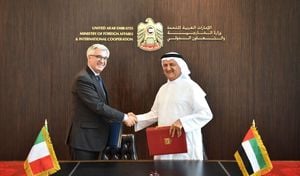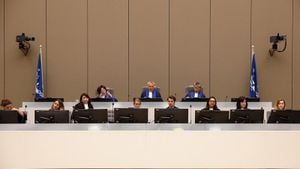The recent German federal election on February 23, 2025, has stirred significant interest as citizens across the nation cast their ballots to elect members of the Bundestag. The Bruchsal-Schwetzingen constituency saw notable developments, particularly the performance of the Christian Democratic Union (CDU) and the rising Alternative for Germany (AfD), reflecting shifting political tides.
Olav Gutting of the CDU emerged victorious once again in this pivotal region, securing 36.1% of the First votes. This marked a substantial increase from the 29.6% First votes he received during the last election held in 2021. Gutting, who previously served as a Bundestag representative, successfully defended his seat, underscoring the CDU's stronghold in the area. "Olav Gutting 'zieht per Direktmandat' ins Bundestag ein," reported the Südkurier, highlighting Gutting's direct mandate win.
Following Gutting was Tobias Dammert from the AfD, who garnered 22.2% of the First votes—a significant surge of 10.8 percentage points from the previous election. This growth has made the AfD the second most preferred party within the Bruchsal-Schwetzingen constituency, illustrating the shifting voter sentiments away from traditional parties.
The Federal Election 2025 was notable not only for the intensified competition between these parties but also for the increase in voter engagement. The turnout for the Bruchsal-Schwetzingen constituency was reported at 83.5%, slightly higher than the national average of 83.4% and markedly up from 77.8% seen during the last Bundestag elections. According to reports, "Die Wahlbeteiligung stieg im Wahlkreis von 77,8 Prozent auf 83,5 Prozent," indicating a clearer voter interest and mobilization effort this time around.
When examining the Second votes, which are indicative of party preferences at the federal level, the CDU retained its leading position, receiving 32.1% of the votes. The AfD followed with 22.4%, whilst the Social Democratic Party (SPD) only managed to secure 14.4% of the votes. This shows not only the strength of the CDU but also the growing concerns among voters, reflected in the AfD's ascent.
The political overview also indicates substantial losses for the coalition parties known as the Ampelkoalition—specifically the SPD, Greens, and FDP—bringing their combined Second votes down to 30.5% compared to 51.2% during the 2021 elections. This watershed moment suggests dissatisfaction with the current ruling coalition, potentially signaling unrest and shifts for future elections.
It is also worth noting the performance of the newly participating BSW party, which secured 4.3% of the votes. Such dynamic participation with 29 parties standing for election is unprecedented and reflects Germany's vibrant multi-party system.
Each locale within the Bruchsal-Schwetzingen constituency showed varying results, with some municipalities favoring the CDU significantly more than others, demonstrating localized voting patterns. For example, Olav Gutting received as much as 44.7% of the votes in Hambrücken but saw only 32.8% in Neulußheim.
The results from the election paint a compelling picture of the shifting political dynamics within not just Bruchsal-Schwetzingen but throughout Germany at large. The ramifications of these elections will likely influence party strategies as they prepare for the next electoral rounds and address the concerns of their constituents.
Overall, the Federal Election 2025's outcome hints at possible future shifts within the German political system, as increased participation reflects growing public engagement. The notable success of smaller parties such as the AfD and BSW also suggests the electorate's willingness to explore alternatives to established parties, potentially reshaping Germany’s political fabric for years to come.



